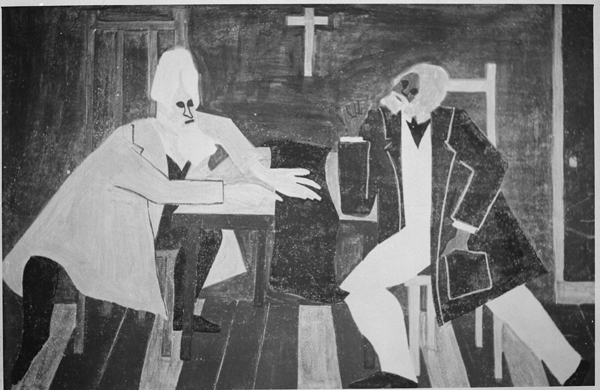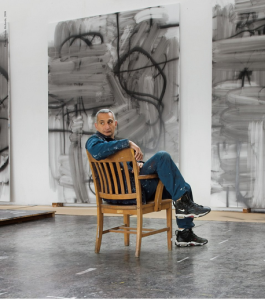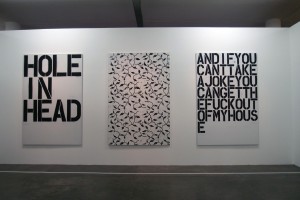Venus & Jupiter: The Conjunction of Brown & Powell

Frederick Douglass argued against John Brown’s plan to attack the arsenal at Harpers Ferry, Jacob Lawrence
One hundred and fifty years ago, a man named John Brown was put to death by the state. He was not gunned down in the street, nor was he unarmed. He was arrested by Robert E. Lee for leading a raid on the national armory at Harpers Ferry, Virginia. He had planned to arm America’s slaves with a hundred thousand guns. He was a white man, a preacher. Newspapers called him “a madman.” In most pictures he had “crazy eyes.” Abe Lincoln declared him “insane.” One thing’s for sure, he was mad. His rage boiled over.
American poets compared Brown’s life to a meteor that tore across the sky as he sat in jail, very nearly bisecting the interim of his conviction and execution. Emerson called him a saint, “whose martyrdom, if it shall be perfected, will make the gallows as glorious as the cross.” Thoreau said, “When a man stands up serenely against the condemnation and vengeance of mankind, rising above them by a whole body . . . the spectacle is a sublime one.” Both had attended his speeches and probably knew about the raid before it happened. Years later, Melville wrote, “the streaming beard is shown / (Weird John Brown), / The meteor of the war.” Whitman, who was there, put him in Leaves of Grass: “YEAR of meteors! brooding year! / I would sing how an old man, tall, with white hair, mounted the scaffold in Virginia; / (I was at hand—silent I stood, with teeth shut close—I watch’d; / I stood very near you, old man, when cool and indifferent, but trembling with age and your unheal’d wounds, you mounted the scaffold;)” The actor John Wilkes Booth was there, too. He wrote his piece in Lincoln’s blood.
Even Victor Hugo, in exile, called for Brown’s pardon. “There is something more frightening than Cain killing Abel,” he said, “and that is Washington killing Spartacus.” READ MORE >
THE PERENNIAL AMBIGUITY OF CHRISTOPHER WOOL
I like Christopher Wool’s artwork. Wool became famous for his paintings of strong, provocative phrases in black letters, primarily ALL CAPS. Wool’s works are of an abstract nature, sometimes intricate in presenting an idea, other times arcanely elusive. In October’s Vogue Dodie Kazanjian scored a rare interview with the media-reclusive artist. The format and presentation of the arguments the writer provides to the text more closely resembles that of an essay, but many intriguing themes come up.
By introducing Willem de Kooning’s approach to artistic work–who worked “out of doubt”–as a starting point, the writer reveals the artistic intentions of Wool to be consistent in their omnipresent questioning and doubting. They are works defined by what Kazanjian calls a “perennial ambiguity.” This ambiguity may also be viewed as the proclamation of the honest confusion of an artist. Thus, the refusal of adopting an authoritative style should not be considered the result of limited intellectual rigor, but rather should be respected for its humility.
Discussing his artistic aspirations and how he managed to become a significant part of the modern art world, Wool asserts that his path was somewhat coincidental. “It just kind of happened,” he states. A key to his success was possibly that his early years in New York coincided with a legendary era of NY nightlife and culture: CBGB and Max’s Kansas City. The intersection of nightlife and the art-reality that was being created was evident in the 1980s, and shaped the public’s perception of artists’ role.
Upon revisiting his old work, the artist himself confesses: “They were offensive, funny, and indelible–you had to pay attention.” Consequently, it is not surprising that the critical response to his work varied. Some thought it populist in its negativity, while others observed in it a radical stance: a cacophonous harmony, or a refreshing pathos. What is predictable in his work is Wool’s lack of “conclusiveness” or the absence of artistic closure.
“I firmly believe it’s not the medium that’s important, it’s what you do with it,” the artist clarifies.


